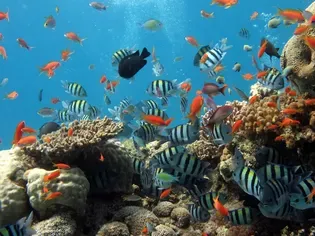Saltwater Aquarium Fish Compatibility Chart
Updated on 04/26/24

Essential Guide to Saltwater Aquarium Fish Compatibility: The Ultimate Chart
Embarking on the captivating journey of saltwater aquarium keeping entails meticulous planning and careful consideration of the compatibility of your chosen aquatic inhabitants. Creating a harmonious and thriving underwater ecosystem requires knowledge of the intricate relationships between different fish species, their temperaments, and their environmental requirements. To empower you in this endeavor, we present the definitive Saltwater Aquarium Fish Compatibility Chart, an indispensable tool to guide your decision-making process and ensure the well-being of your finned companions.
Navigating the Saltwater Aquarium Fish Compatibility Chart
Our comprehensive chart encompasses a vast array of saltwater fish species, meticulously categorized according to their compatibility levels. Each fish species is assigned a color-coded indicator, ranging from green (highly compatible) to red (highly incompatible), providing an instant visual reference for compatibility assessment. Additionally, the chart includes valuable information on the ideal tank size, water parameters, and dietary preferences of each species, empowering you to create an environment that meets their specific needs.
Understanding Fish Compatibility
The compatibility of fish species is influenced by a multitude of factors, including:
- Temperament: Some fish species are inherently aggressive, while others are more peaceful. Mixing incompatible temperaments can lead to conflict and stress, potentially harming or even killing the more timid fish.
- Diet: Fish with similar dietary preferences can cohabitate harmoniously, reducing competition for food. However, introducing fish with vastly different diets can disrupt the feeding habits of others, leading to malnutrition or aggression.
- Size: Larger fish may perceive smaller fish as prey, while smaller fish may feel threatened by larger ones. Maintaining a balance in size can help prevent predation and intimidation.
- Water Parameters: Fish species have specific requirements for water temperature, salinity, and pH levels. Incompatible water parameters can cause stress, disease, and even death.
- Habitat: Some fish prefer open spaces, while others seek shelter in caves or among coral. Ensuring a variety of habitats allows all fish to find suitable hiding spots and prevent territorial disputes.
Examples of Compatible and Incompatible Species
To illustrate the importance of fish compatibility, let's explore some examples:
- Compatible: Clownfish and damselfish are both peaceful species that thrive in similar water parameters and enjoy a varied diet. They can coexist harmoniously in a community tank.
- Incompatible: Lionfish and butterflyfish are incompatible due to their vastly different temperaments and dietary preferences. Lionfish are predatory and may attempt to eat butterflyfish, while butterflyfish may stress lionfish with their constant swimming and feeding habits.
- Partially Compatible: Tangs and angelfish can coexist in a larger tank with ample hiding places and a varied diet. However, if the tank is too small or there is insufficient shelter, tangs may become aggressive towards angelfish.
Conclusion
The Saltwater Aquarium Fish Compatibility Chart is an invaluable resource for creating a thriving and harmonious saltwater aquarium. By understanding the compatibility of different fish species and tailoring their environment to their specific needs, you can provide a sanctuary where your aquatic companions can flourish. Remember, compatibility is not a guarantee, and observing your fish closely for any signs of stress or aggression is essential for their well-being. May your underwater journey be filled with vibrant colors, peaceful interactions, and the enduring joy of a well-balanced saltwater aquarium ecosystem.
Explore More Pets

Freshwater Aquarium Filters
How to Deal With Cloudy Aquarium Water

Saltwater Aquarium Filters
How Do You Remove Chloramines From Tap Water?

Freshwater Aquariums & Habitat
Can I Keep My Koi Fish Inside?

Saltwater Aquariums & Habitat
14 Best Floating Plants for Your Aquarium

Freshwater Fish Health
How to Treat Ich on Freshwater Fish

Saltwater Fish Health
Fin Rot in Aquarium Fish

Freshwater Aquarium Filters
How to Do Aquarium Water Changes

Saltwater Fish Health
How Do Fish Get Parasites?